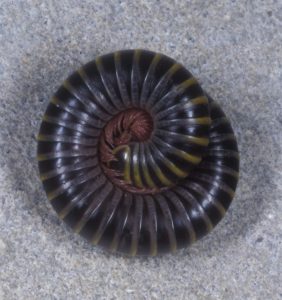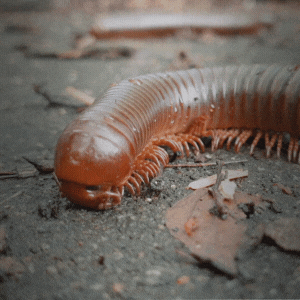
As our community continues to recover from recent storms, find helpful resources and information at tiny.cc/ufsaraext_disasterprep, tiny.cc/saraco_disasterprep, and scgov.net/government/emergency-services/storm.
This blog is part of a multi-part series. To meet other members of “The Spooky Bug Brigade,” visit our blog’s landing page.
Millipedes (Diplopoda)

Credit: Lyle Buss, UF/IFAS
Description

Credit: Lyle Buss, UF/IFAS
Contrary to popular belief, millipedes do not have a “thousand legs,” like the prefix implies. In fact, the number of legs a millipede has is entirely dependent on the species. They typically have anywhere from 40 to 400 legs, but one species from western Australia, Eumillipes persephone, has been found to have as many as 1,306 legs. What makes a millipede different from a centipede is the pairs of legs per body segment. Millipedes have two pairs per segment, while centipedes only have one. Another big difference is that centipedes have biting mandibles, while millipedes do not. Millipedes are also known to curl up in a ball when threatened or dying.
There are dozens of species present in Florida, with the most common being the bumblebee millipede (Anadenobolus monilicornis), rusty millipede (Trigoniulus corallinus), and the Florida ivory millipede (Chicobolus spinigeru). The former two are invasive, while the latter is native to the state.
Services
Though sometimes a nuisance in the home, millipedes should be a welcome visitor to the garden. As detritivores, they break down organic matter, like leaves, wood, and fruit, and recycle those nutrients back into the earth. That means that millipedes help increase the health of your soil!
Habitat

Credit: Varunee Somwat from Getty Images Signature; designed in Canva
Millipedes need moisture to survive. Since they feed on decaying organic matter, millipedes can be found in compost piles, under mulch in landscape beds, under rocks and logs, and in topsoil. When they do come inside your home, it is often because their home was recently flooded. Excess moisture from recent rainfall or irrigation can fill in any air gaps present in the soil, making it difficult for soil-dwelling organisms to breathe. This forces them out to seek dry land. Often times, this is the nearest structure they can find.
When millipedes gather inside your home, you can use a broom and dustpan to sweep them up and relocate them outside. If they have already dried up and died, you can use a vacuum for convenient disposal. To prevent future infestations, take care to limit possible entry points. Use weatherstripping to close gaps around doors and windows, and seal any cracks and crevices around your foundation.
Fun Fact
Some species are known to emit a defensive compound that contains trace amounts of hydrogen cyanide! While not deadly, it can certainly be irritating to the skin. Always handle millipedes with caution, taking care not to pick any up with your bare hands – especially if you don’t know what it’s capable of.
Learn more about the many-legged millipede by clicking here.
Resources
- UF/IFAS Featured Creatures: https://entnemdept.ufl.edu/creatures/
- UF/IFAS Insect ID Lab: https://entnemdept.ufl.edu/insectid/
- IPM Florida: https://ipm.ifas.ufl.edu/
- UF/IFAS Extension Sarasota County, Chemicals in the Environment: https://sfyl.ifas.ufl.edu/sarasota/natural-resources/chemicals-in-the-environment/
Credits
- Featured image: Cristina Carrizosa, UF/IFAS
- Photos: Credited in caption
- Graphics: Designed in Canva
 4
4
